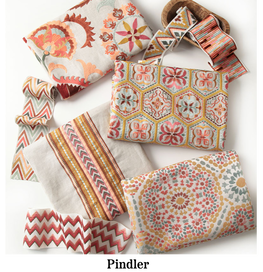The Perfect Fabric
Choosing fabric for your project can seem daunting, but we can help guide you through this fun adventure. Home Again has a number of in-stock options, but we also carry 18-different fabric companies with literally thousands of fabric options in a wide range of patterns, styles, price points, and materials available to our clients, designers, and the general public. We welcome you to pop by at your convenience to browse the fabric library and borrow samples.
If you're going to spend the time and money to reupholster a piece, the fabric that you choose should be durable enough for whatever you plan to throw at your furniture. While you may not need to be so picky about an occasional chair in the corner of your bedroom, if you're recovering dining chairs for a table that your family routinely gathers around, you need to know what makes a fabric durable.
- DOUBLE RUB COUNT: A rub count is a measure of how many times a fabric can be abraded before it starts to show wear. Different tests may have different names, but the same principle applies - the higher the number, the more durable the fabric. Some people estimate that 3,000 double rubs is the equivalent of 1-year of average use. Expert opinions vary, but we tell clients that the minimum count for fabric being used to upholster furniture is 15,000. However, aiming for 30,000 is preferable for a routinely used piece. 100,000+ double rubs is considered commercial grade fabric that is designed to withstand daily use in a hospital waiting room, restaurant, or airplane seat.
- WEIGHT: Your high school science teacher taught you that mass and weight are not the same, but the world of fabric doesn't heed that distinction. When you see the weight listed, it is actually the mass of a piece of fabric (ounces per square yard) because some threads weigh more than others. So in the U.S., you'll usually see this displayed as ounces. For example, a gauzy fabric might be 4oz and a denim more like 9oz. The denim feels thicker and heavier. You're usually going to be looking in the 6-12 oz range, though the application also matters. If you have a piece with delicate folds, sharp curves, or deep tufts, 12 oz fabric isn't going to be as graceful as something in the 6 oz range.
- MATERIAL: If you're looking for absolute durability, leather or a faux leather are going to provide you with unbeatable performance. Of course they can't stand up to repeated clawing from a cat, but they do excel when it comes to staining, fading, and fiber wear. Faux leather can get a bad rap, but today's options are textured, colorful, pliable. Natural fibers like cotton and linen are quite strong because of the tightly woven fibers, but they aren't as stain or fade resistant. As soon as you add polyester into the mix, the durability goes up significantly.
- PATTERN and COLOR: While you're certainly considering pattern and color for their aesthetic value, you should also know that they can influence how your furniture wears. Something with a busy pattern is going to hide imperfections much more than a solid color. And if you're going with a solid color, selecting a textured fabric, like a chenille or tweed provides stains or snags with a bit of cover.
- TREATMENT: Many fabric lines offer the option to apply a protective treatment to fabric to further protect it against stains and fading. Many of the fabrics in the Home Again library are (or can be) treated to turn them into high performance material that will hold up against whatever your toddler throws at it. Many people are familiar with Crypton, which is fabric that, as its name suggests, is practically indestructible. However, Crypton is essentially a type of treatment that is added to an otherwise "normal" upholstery fabric. Other treatment names include Alta, FibreGuard, or Nanotex Asure. When you see these names used to describe a fabric, you know you're getting upholstery fabric with an extra shot of durability.






















